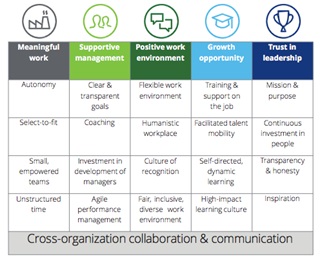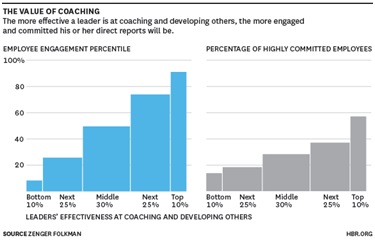Research Paper By Diane Long
(Leadership Coach, JAPAN)
Introduction
I have spent the last fifteen plus years within the Human Resources profession at multi-national financial services corporations, where I partnered closely with leaders on developing and implementing people strategy. A consistent theme has come about which I will explore in this paper. Specifically, I will discuss the need for leaders to be coaches and the behaviors of a “leader as coach”.
I will take a storytelling approach to bring this paper visually to life. I have created a fictional character named “Brooklyn” to represent the majority of leaders in the corporate world. This name is inspired by the neighborhood I grew up in and it is a gender-neutral name. However, for this paper, Brooklyn will be female since so many papers usually default to the male gender.
Fictional Case Study
Brooklyn began her life in the way all of us begin our lives – as an “individual contributor”. From the time she was born until she finished her time as a student, she had two individual contributor roles: 1) as a student in school and 2) as a member of her family. For the most part, she was not responsible for anyone else. Perhaps she took care of a family pet or babysat a younger sibling, but her primary role was student and family member. The leaders in her life were the person(s) who raised Brooklyn and the teachers at her school.
In this case, Brooklyn finishes her undergraduate degree and joins a large corporation in an entry-level position. She is still an “individual contributor”. Brooklyn receives on-the-job training. Depending on her position, she may also receive classroom or online training. She performs well and receives various promotions in the corporation. Her role expands from providing an individual contribution to also managing other people. Her performance is now assessed not only on her contribution but the contributions of her team.
Initially, she manages one to two people whose work directly feeds into her work. For example, the draft reports which she used to be responsible for, but now, she reviews the final version before sending out. Their tasks are relatively simple and she is very familiar with them because she, herself, had these same responsibilities when she first started in her entry-level position.
Her performance continues to be strong and she receives another significant promotion. This time around, she is taking on responsibility for work she doesn’t have as much deep exposure to. She has direct reports who have greater subject matter expertise but rely on her for the larger company perspective. She has greater seniority in the firm as do her direct reports. Some of her direct reports are people managers with smaller teams of their own.
External Research
In a 2000 Harvard Business Review study[1], Daniel Goldman shares his research of more than 3,000 executives to explore six distinct leadership styles – each springing from different components of emotional intelligence. An effective leader can shift their style based upon the situation and the people and one of these six styles are Coaching.
 [2]Coaching is best described as the “try this” style where the focus is on developing people for the future. As a coaching leader, Brooklyn helps her direct reports identify their unique strengths and weaknesses and making the connection of these with their aspirations. Clear long-term development goals are set which develops trust and engagement between herself and her team members. Brooklyn delegates to her team, allowing them to grow through challenging assignments and allows for failure so they may learn.
[2]Coaching is best described as the “try this” style where the focus is on developing people for the future. As a coaching leader, Brooklyn helps her direct reports identify their unique strengths and weaknesses and making the connection of these with their aspirations. Clear long-term development goals are set which develops trust and engagement between herself and her team members. Brooklyn delegates to her team, allowing them to grow through challenging assignments and allows for failure so they may learn.
Unfortunately, Goldman’s research found this is the style least used by leaders.
Many leaders told us they don’t have the time in this high-pressure economy for the slow and tedious work of teaching people and helping them grow. But after a first session, it takes little or no extra time. Leaders who ignore this style are passing up a powerful tool: its impact on climate and performance are markedly positive.
 What these leaders also don’t understand is that research has shown employees desire more coaching from their leaders. Deloitte has trademarked what they call “The Simply Irresistible Organization” (see image to the right).[3]Positive coaching is seen as a must with their research suggesting a “five-to-one” ratio of encouraging feedback to criticism. Companies should also promote continual coaching and frequent check-ins instead of once a year of performance reviews.
What these leaders also don’t understand is that research has shown employees desire more coaching from their leaders. Deloitte has trademarked what they call “The Simply Irresistible Organization” (see image to the right).[3]Positive coaching is seen as a must with their research suggesting a “five-to-one” ratio of encouraging feedback to criticism. Companies should also promote continual coaching and frequent check-ins instead of once a year of performance reviews.
If Brooklyn takes on the role of coach with her direct reports, she provides “Supportive Management” through a focus is on helping them improve job performance and develop long-term strengths. Mercer’s 2020 Global Talent Trends report[4] also promotes the need for coaching to helping employees navigate change. The below highlights the top five reskilling barriers for employees.

Facilitating Learning and Results is one of the groupings in the ICF Core Competency Framework[5] and if Brooklyn takes the time to coach her employees, she will be able to help them formulate the plan to acquiring new skills as well as recognize and reward her employees for reskilling themselves.
There is a clear business necessity for corporations to encourage their leaders to develop coaching skills. As I write this paper, the world is dealing with COVID-19, a global pandemic, which has required new ways of working to keep business moving. Almost everyone I know is using the video chat platform Zoom for both personal and professional calls. Regardless of how long this crisis will last, the economic impact is significant.
The traditional “Command and Control”[6] approach to management simply won’t work as enforcing rules and policies is much more challenging when everyone is working remotely. Working remotely requires trust in your employees and acting as a coach to employees will help them be more effective as independent workers.
So let’s go back to imagining Brooklyn as a coach. What does this look like? In reality, it will not be what ICF define as pure coaching.[7] Brooklyn is also a manager and is responsible for providing performance feedback. However, Brooklyn can look at the ICF Core Competencies as a guideline on the skills required to being a successful coach and adapt these into her leadership style.
ICF Core Competencies Interpretation for Leaders as Coaches
Below I have provided some additional thoughts on how to interpret the ICF Core Competencies for leaders using the coaching style.
- Setting The Foundation
- Meeting Ethical Guidelines and Professional Standards – Brooklyn acts with honesty and integrity towards her team members. She communicates the distinction between coaching and giving feedback. She asks for permission from her employees to lead a coaching session. Brooklyn recognizes when the employee requires other support and does her best to identify such resources for the employee.
- Establishing the Coaching Agreement – Brooklyn discusses and agrees with the employee on what the coaching interaction will look like. The two agree on the objectives and the needs of the employee. They agree on how coaching will be beneficial and what outcomes are to be targeted. The two also agree on when and how Brooklyn should bring in her manager perspective (e.g. feedback, guidance, etc.).
- Co-Creating the Relationship
- Establishing Trust and Intimacy with the Client – Brooklyncreates a safe, supportive environment that produces ongoing mutual respect and trust. This is done by keeping promises to support the employee, championing new behaviors and actions, and creating a ‘safe to fail’ environment.
- Coaching Presence–Brooklyn gives 100% of her attention to the employee during her one-to-one conversations. She promotes agility and flexibility, allowing the conversation to go in many different directions. The aim is to give space to her employee to experiment with new ideas and consider different perspectives. She learns to adapt to the employee, finding an approach that fosters the best in this individual – one which helps him/her identify solutions.
- Communicating Effectively
- Active Listening – Brooklyn pays attention not only to the words being spoken to her but the body language of her employee. Her focus is not on her own needs, but on what the employee is looking to discuss and get coaching on. Inactive listening, she can summarize and paraphrase what is said back to the employee. In essence, she aims to act as a mirror helping them get clarity. It also means setting aside judgment (which she might have in her “manager” capacity) and allow the employee to vent.
- Powerful Questioning – Brooklyn asks questions that open up the conversation to a deeper level. It challenges the employee’s current assumptions and evokes commitment and/or action. She asks open-ended questions. She avoids using “why” and instead asks “what” or “how”. She avoids “Yes/No” and uses more, “What else?”.
- Direct Communication – Brooklyn is clear in expressing her desire to share feedback from a manager’s perspective. She is honest and constructive with the intention that this is to benefit the employee. She shares other perspectives the employee may not yet have considered but gives him/her space to think it through. She adapts her language and communication style to be most effective with the employee.
- Facilitating Learning and Awareness
- Creating Awareness –As the manager, Brooklyn should be seeking 360 feedback regarding her employees. As a manager, she should share real-time feedback and incorporate it into any formal performance review processes. When Brooklyn acts as a “coach”, her role is to facilitate a discussion that invokes inquiry in the employee. He/she explores how they perceive their work situation and any feedback they have received. Brooklyn explores the employee’s underlying concerns, breaking down facts and interpretations, and any disparities which may exist. In this process, Brooklyn (as a manager) grows her awareness and understanding of her employee. This will make her a better manager and in the process of helping the employee create self-awareness, she, too, grows awareness. It is in this competency which Brooklyn communicates a broader perspective with the employee. She is careful to ensure that her insights are meaningful and productive to the employee. These insights should help this employee become more effective in reaching his/her objectives. Finally, Brooklyn helps identify major areas of strength and development. She helps the employee understand what his/her priorities are going to be and this sets up well for determining the next steps and the action plan.
- Designing Actions –This is a forward-thinking competency where Brooklyn partners with her employee to identify and create opportunities for ongoing learning. Together, they agree on what the actions will be and the plan to achieve them. The aim is “Do It Now” and Brooklyn’s role is to provide support as needed. She encourages stretch opportunities and new challenges, giving support so the employee doesn’t have a fear of failure. Brooklyn should leverage her perspective as his/her manager in ensuring that the new challenges are also at a comfortable pace of learning.
- Planning and Goal Setting – Brooklyn should use her role as a coach to help the employee determine his/her goals and the action plan for reaching these goals. She helps the employee identify other resources and support. This may be helping the employee expand his/her network in the company, the company provided training, on the job projects, books, podcasts, etc. This is also a great opportunity to identify what early success looks like so that these wins may be celebrated. This contributes to a positive coaching experience.
- Managing Progress and Accountability – Finally, while Brooklyn helps her employee set the plan and goals, she ensures the employee takes full accountability for moving forwards. Brooklyn’s role as both manager and as a coach is to provide support. She sets the context on the bigger picture and strategy behind these goals. She promotes self-discipline, helps the employee collect his/her feedback, and positively confronts the employee when he/she does not take agreed-upon actions.
In Conclusion
Coaching is a critical leadership style for leaders to hone their skills. In one study, 3,761 executives assessed their coaching skills, and then their assessments were compared with those of people who worked with them. Twenty-four percent of the executives significantly overestimated their abilities, rating themselves as above average while their colleagues ranked them in the bottom third of the group.[8]

Over ten years, Zenger Folkman collected responses from some half-million individual contributors worldwide, evaluating about 50,000 of their managers in 360 reviews. The results show just about a perfect correlation between the leaders’ effectiveness in developing others and the level of their subordinates’ engagement and discretionary effort:[9]
This stresses the need for corporations to invest in training for their leaders on coaching best practices. This will likely entail people management training so leaders have fundamental management skills. Organizations should leverage the curriculum of coaching academies like ICA in providing training to develop the ICF core competencies. Finally, some leaders may require their coach to help them unlock their coaching potential. Regardless of what this training should look like, the point is – leaders need to also be coaches.
Resources
[1]https://hbr.org/2000/03/leadership-that-gets-results
[3]https://www2.deloitte.com/content/dam/Deloitte/at/Documents/human-capital/at-is-your-organization-simply-irresistible.pdf
[4]https://www.mercer.com/our-thinking/career/global-talent-hr-trends.html
[5]https://coachfederation.org/core-competencies
[6]https://www.forbes.com/sites/lizryan/2016/02/26/command-and-control-management-is-for-dinosaurs/#15449eba24ed
[7]https://nlp-leadership-coaching.com/the-pure-coaching-model/
[8] https://hbr.org/2019/11/the-leader-as-coach
[9]https://hbr.org/2014/06/finding-the-balance-between-coaching-and-managing
